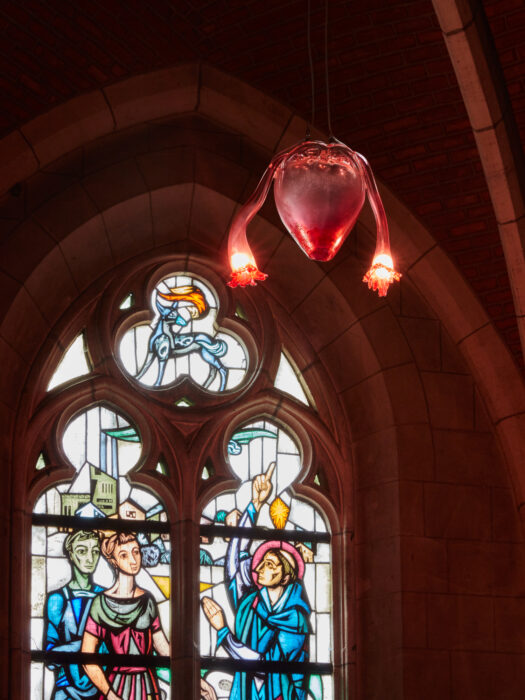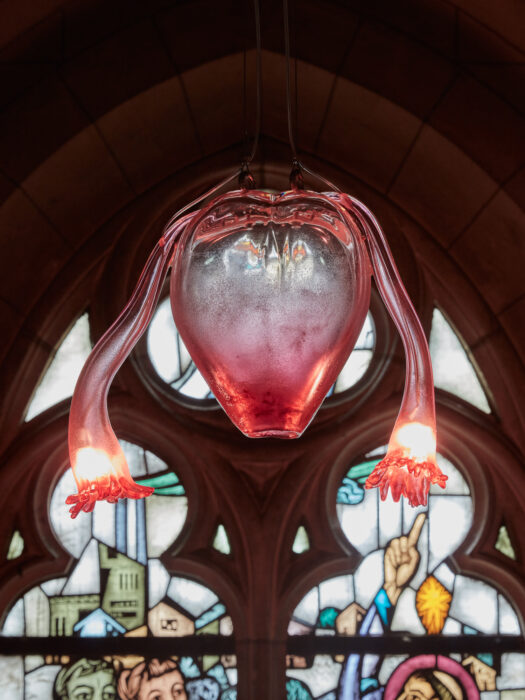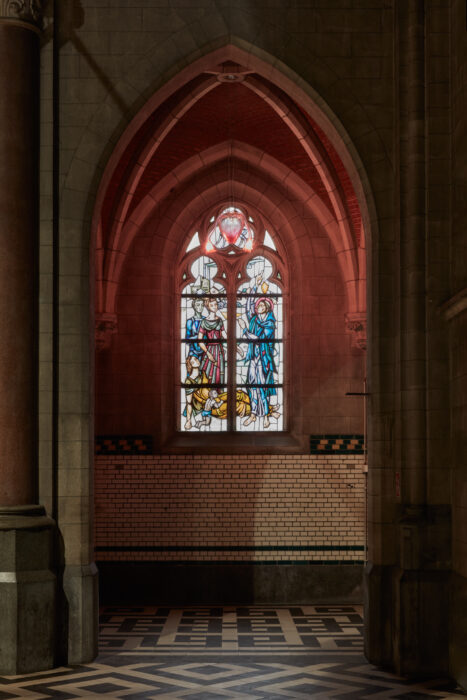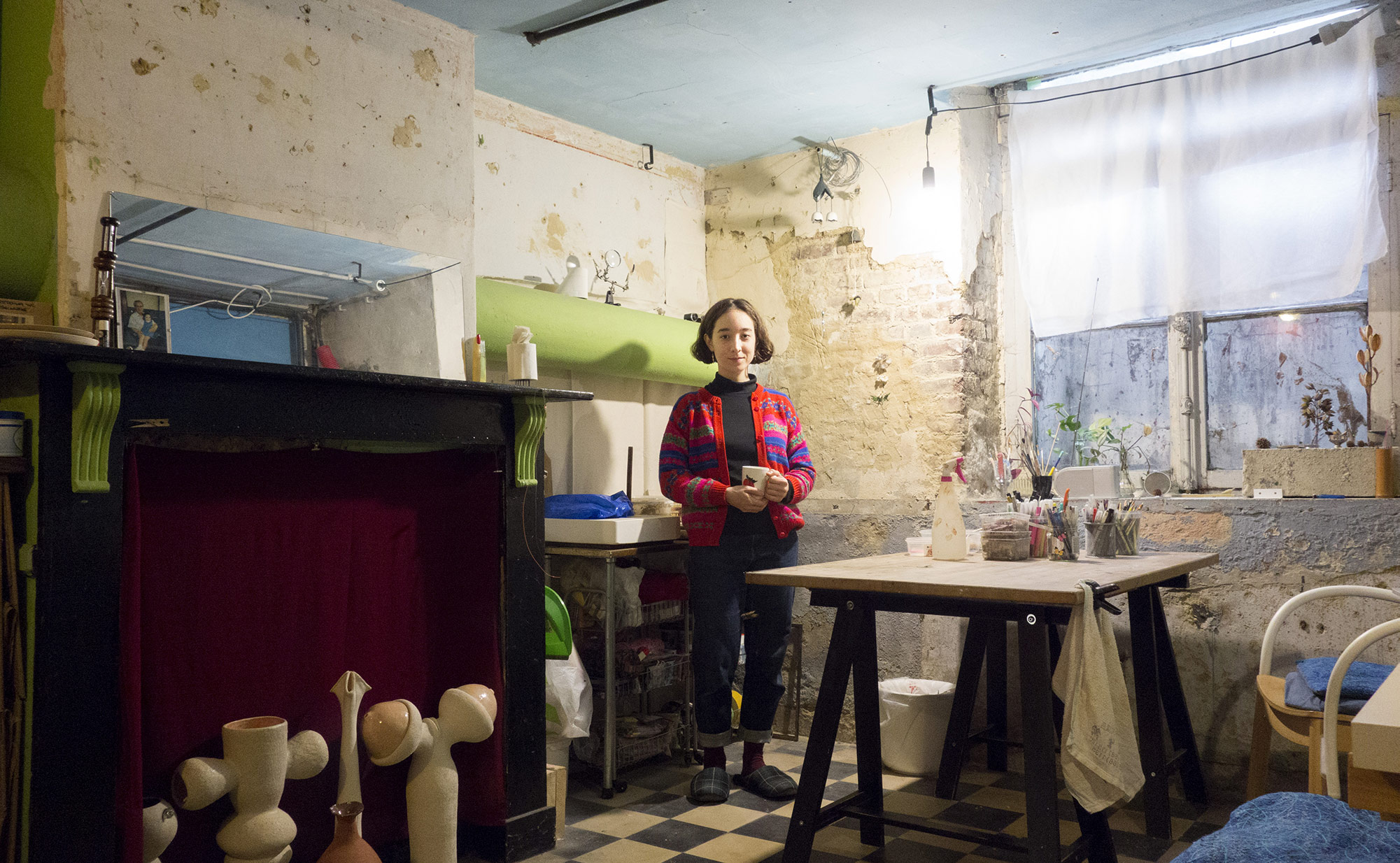



2024, blown glass and led lights, 50x20x40cm
As a part of Periphery exhibition Kunsthal Extra City
semi permanent & site specific installation
Het glaswerk Juana’s Dream van Clara Spilliaert is opgevat als een interventie op maat van de voormalige Dominicanenkerk waarin Extra City is gehuisvest. Deze glazen baarmoeder met lichtgevende eierstokken omsluit de afbeelding van een hond in het glas-in-loodraam achter het werk. De directe inspiratiebron voor de installatie is de legende van Juana de Aza, de moeder van de heilige Dominicus, de stichter van de Dominicanen of Orde der Predikheren, een religieuze broederorde. Een van de vroegste verhalen over de heilige Dominicus dateert uit de twaalfde eeuw. De legende vertelt dat Dominicus’ moeder voor zijn geboorte droomde dat een hond uit haar baarmoeder sprong met een brandende fakkel in zijn bek waarmee hij de aarde in brand leek te steken. Het verhaal is waarschijnlijk ontstaan toen de broederorde bekend werd als de Dominicaanse orde, Dominicanus in het Latijn. Die naam werd geïnterpreteerd als: Domini canis of ‘hond van de Heer’. In die woordspeling vindt de hond als prominent symbool binnen de iconografie van de Dominicanen zijn oorsprong, al is die niet algemeen bekend. Ze raakte geïntrigeerd door het verhaal van Juana de Aza en creëerde deze poëtische, contemplatieve installatie om de aandacht te richten op de verbanden tussen gender en spiritualiteit, de menselijke relatie tot de natuur en de rol van symboliek in de vorming van individuele en collectieve identiteit. Als bezoeker kan je het beeld van de hond in de glazen baarmoeder zien vanuit een specifiek gezichtspunt dat voor iedereen anders is. (Tekst door curator Zuzanna Rachowska)
「フアナの夢」は、Kunsthal Extra Cityの所在地である旧・聖ドミニコ修道院でのサイトスペシフィックな作品として着想されました。光る卵巣を持つこのガラスの子宮は、作品後方にあるステンドグラスの犬のイメージに重なります。インスピレーションの源は、聖ドミニコの母、フアナ・デ・アザの伝説です。 聖ドミニコに関する最も古い12世紀の伝記の中に、聖ドミニコが生まれる前に母親が見たという、燃える松明をくわえた犬が子宮から飛び出してくる夢の記述があります。ドミニコ会(ラテン語ではドミニ=主・カヌス=犬)の言葉遊びとして、この逸話はのちに「主(神)の犬」と解釈されました。 ここから、同教会の図象には多くの犬が登場します。 それにもかかわらず、その起源は一般には知られていません。 フアナ・デ・アザの夢の物語に触発されたスピリアールトは、ジェンダーと精神性のつながり、自然と人間の関係、そして個人と集団のアイデンティティの形成におけるシンボルの役割に焦点を当てるために、この詩的で瞑想的なインスタレーションを制作しました。訪問者は、ガラスの子宮に囲まれた犬を、人それぞれの異なる視点から見ることができるでしょう。(文・キュレーター ズザンナ・ラチョスカ)
The glasswork Juana’s Dream by Clara Spilliaert is conceived as a site-specific intervention in the former Dominican church in which Kunsthal Extra City is housed. This glass womb with luminous ovaries encloses the image of a dog in the stained glass window behind the work. The direct source of inspiration is the legend of Juana de Aza, the mother of Saint Dominic, the founder of the Dominican Order of Preachers. One of the earliest narratives on Saint Dominic, from the twelfth century, tells that before his birth, his mother dreamt that a dog leapt from her womb carrying a flaming torch in its mouth and seemed to set the earth on fire. The story is likely to have emerged when the Dominican order (Dominicanus in Latin) became known as such. Through a play of words, the Latin was interpreted as Domini canis, ‘Dog of the Lord’. From here derives the symbol of the dog that is so present in the order’s iconography. Nevertheless, its origin is not commonly known. Intrigued by the ambiguous story of Juana de Aza, she created this poetic contemplative installation to focus on connections between gender and spirituality, the human relation to nature and the role of symbolism in forming individual and collective identity. Visitors can see the image of the dog enclosed in the glass womb from a specific viewpoint, which is different for each person. (text by curator Zuzanna Rachowska)
Photo: We Document Art




